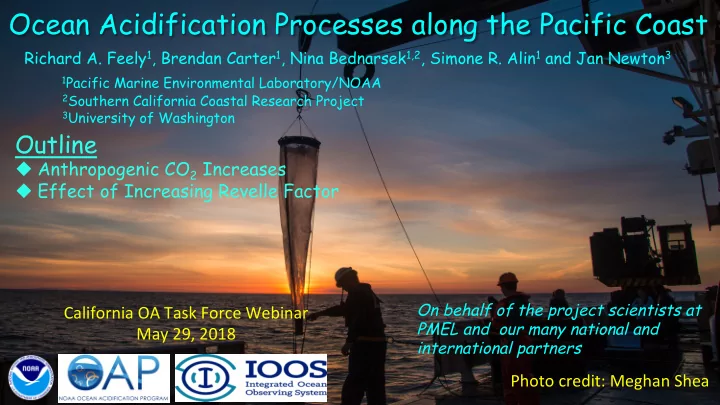

Ocean Acidification Processes along the Pacific Coast Richard A. Feely 1 , Brendan Carter 1 , Nina Bednarsek 1,2 , Simone R. Alin 1 and Jan Newton 3 1 Pacific Marine Environmental Laboratory/NOAA 2 Southern California Coastal Research Project 3 University of Washington Outline u Anthropogenic CO 2 Increases u Effect of Increasing Revelle Factor On behalf of the project scientists at California OA Task Force Webinar PMEL and our many national and May 29, 2018 international partners Photo credit: Meghan Shea
Anthropogenic Carbon Dioxide Concentrations and p CO 2 Increase in the North Pacific [µmol kg -1 ] Pacific anthropogenic carbon from 1995 to 2015 winter/spring 2014-15 warm anomaly Depth [m] Accomplishments: Repeat hydrography (left) continues to demonstrate the growing global ocean CO 2 sink while fixed time series stations (top) illuminate how interannual events, such as “the blob,” impact CO 2 flux (from Carter et al. 2017; Carter et al. in prep; Feely et al. 2018; Sutton et al. 2017)
An Integrated Federal-State West Coast Ocean Acidification Observing Network Tuned to local/regional needs and providing real-time information to stakeholders and partners via the IOOS Pacific Region Ocean Acidification Data Portal (ipacoa.org) Alin et al. 2015, in press (L); Chavez et al. 2017 (R) • Increasing CO 2 levels in the ocean increases its acidity (lowers its pH). These processes are faster in California coastal waters due to the combined effects of acidification, upwelling, and local carbon and nutrient sources. • Observations and modeling studies indicate that local anthropogenic carbon and nutrient sources provide significant contributions to local acidification but vary widely depending on location.
Aragonite Saturation Depth (m) (2016) Aragonite Saturation Depth (m) (2007) NOAA West Coast Cruise 8 May – 6 June 2016 compared with May-June 2007 u Aragonite saturation depth indicates strong upwelling near the coast from northern California to Vancouver Island.
Anthropogenic CO 2 vs potential density in the California Current System Anthropogenic CO 2 is calculated from PO2 2013 Repeat Hydrography 2011 2007 cruises in 2004 and 2004 2013 and then interpolated onto California Current System potential density surfaces. Richard Feely – PMEL
Anthropogenic Carbon Distributions in 2016 May-June 2016 C anth µmolkg -1 • High C anth surface values (55-66 µmolkg -1 ) offshore and to the south • Low C anth subsurface values (40-54 µmolkg -1 ) in onshore waters from Hecata Head to Point Reyes • Low C anth waters everywhere below 100m Feely et al., in prep
Evolution of chemical conditions in the California Current Ecosystem Decadal trend in anthropogenic carbon concentration and aragonite saturation changes from the preindustrial to present Anthropogenic CO 2 (µmol/kg) Change in aragonite saturation state
Evolution of chemical conditions in the California Current Ecosystem Decadal trend in anthropogenic carbon rate of change in the water column
Surface water changes over time pH: lower in West Coast surface waters similar decreases from present-day Ω arag : lower in West Coast surface waters larger decreases in GOM from present RF = (∆ p CO 2 / p CO 2 )/(∆DIC/DIC) changes more rapidly in the cooler West Coast waters Feely et al (2018)
Past, Present and Future Impacts of Ocean Acidification In coastal environments like the Salish Sea, the increasing anthropogenic carbon reduces the ability of the system to buffer natural variations in CO 2 . This reduced buffering capacity leads to preferential amplification of naturally extreme low pH and high pCO 2(s.w.) events above changes in average conditions, which outpace rates published for atmospheric and open-ocean CO 2 change . -Pacella et al., PNAS 2018
Conclusions . u Our major challenge is to determine anthropogenic ocean acidification changes and biological responses against a backdrop of large natural variability. Approach to Solve: Collaborative Monitoring and Modeling u Co-located chemical/biological field observations provide unique opportunities to observe and understand long-term changes as impacted by ocean acidification and hypoxia. Approach to Solve: Collaborative Monitoring and Modeling u Oyster larvae, Pteropods and Crab larvae exhibit physiological responses that appear to be impacted by ocean acidification now. Approach to Solve: Continued Collaborative Field and Laboratory Studies
Recommend
More recommend